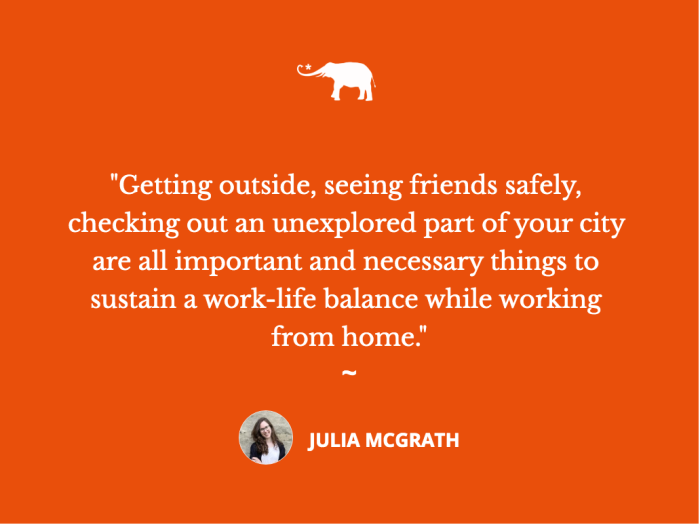View this post on Instagram
Does reading this title make you groan with exhaustion?
While many of us have returned to work in person at the time of writing (March 2022), many people continue to work remotely, either full time or in a hybrid model.
While many things have changed over these last two years, some of the struggles of work from home (WFH) remain. As a small virtual business owner and a therapist, my core values are to help others (and myself) live compassionate lives and suffer less.
My practice, Aligned Life Therapy, typically sees clients who are millennials struggling with anxiety, self-criticism, perfectionism, and burnout.
In my experience surviving and helping others to lead better lives during the pandemic, here are a few critical strategies that are therapist-approved and shown to help:
Having a Dedicated Workspace
When I launched my practice, I was living in a studio apartment. While space was tight, I created my “therapy corner” and did my best to keep my work materials, like notes and my computer, in that corner. Having work items scattered across the apartment made me feel like there was no separation between home and work.
Eventually, I moved in order to have a dedicated home office space. Being able to close that door when I’m done with sessions has truly improved my quality of life. My clients who WFH have also been able to create office closets, repurpose spare bedrooms, and create a desk space within their homes that is designated for work.
If you are still working from the couch or bed, I recommend this as my number one tip for your WFH mental health.
Time Blocking and Boundaries
When working from home, work becomes an amorphous thing that can fill the whole day and lead people feel like they’re constantly working. I recommend time blocking to clients who work from home. To me, this is really seizing the beauty of having control over your schedule and practicing healthy boundaries that weren’t always accessible in the office.
I start working at 9:30 a.m. after enjoying a morning routine involving tea and reading a non-therapy related book. My “block” for sessions is between 11 a.m. and 6 p.m. I use a specific planner called “passion planner” that allows me to schedule by the half hour.
At the start of each week, I block off time for lunch, a few yoga sessions, and time for marketing. I also draw a line across my end time in my planner as a visual reminder that I will not allow work to creep past 7 p.m. I’m not striving for perfection, but having this framework keeps me accountable to myself.
Remember the Limits of your Role
Oftentimes, I hear that clients are doing more at work than their role technically requires. Taking on more responsibility can happen without you even realizing it. We want to do well and be a team player, but for many people, this leads to being overwhelmed.
Does your role involve set hours? Does it require you to pick up others’ slack? Remembering your role can help set fair boundaries with yourself and coworkers. When that email comes in at 4:55 p.m. asking for help on someone else’s project the night before the deadline, try asking yourself if this is truly required of you. You can politely explain that you do not have time to get to it and request advanced notice for next time.
While I myself don’t have coworkers, I do have to remind myself that as much as I’d love to wave a magic wand and relieve my client’s suffering instantly, it’s just not possible. Reminding myself of the limits of my role has helped me immensely.
Check your Perfectionism
Good enough is good enough. Perfectionism stems from a desire to be safe by doing the most to “ensure” that things will be okay. It’s understandable, but sometimes the facts don’t fit the feelings. This can show up for me when I’m working on a blog, and I feel the desire to get my every nuanced thought out there in order for it to be good enough.
I especially see this when clients work on collaborative projects. I encourage them to lean into the process and allow themselves to submit what they have and benefit from feedback. Also, it’s important to ask yourself: Does the task at hand truly need to be “perfect?” The answer is often no.
Hit send on that email and move on! And in my case, publish the imperfect blog because otherwise I’d never publish anything.
Develop a Work Transition Ritual
This could range from spiritual to practical, and all that matters is that it’s helpful to you. It’s just something you develop with the intention of marking the end of the work day and starting your down time.
I change out of my “work” clothes into lounge clothes. I ceremonially close my office door and celebrate that I’m done. I’ll turn on music and dance while cooking dinner. Some clients have benefited from lighting candles, changing the lighting, or debriefing with a partner or roommate.
Make Room for Joy
Lastly, make sure you schedule things you enjoy or novel activities as well. It can feel really monotonous being at home all day. Getting outside, seeing friends safely, checking out an unexplored part of your city are all important and necessary things to sustain a work-life balance while working from home.
From one WFH therapist who truly gets the struggle, I wish you health and wellness as we continue on two-plus years into the pandemic.
~











Read 1 comment and reply